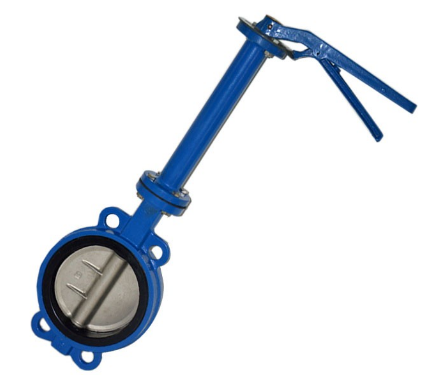In fluid control systems, precision and efficiency are paramount. Butterfly valves, known for their versatility, ensure consistent flow management across various sectors. The GGG50, extended stem, and concentric disc butterfly valves stand out among their peers. To assist in your selection, an examination of their characteristics, uses, and distinctions is presented, tailored to your specific flow control requirements.
GGG50 Butterfly Valve: Precision in Performance
Crafted from high-grade ductile iron, the GGG50 butterfly valve is renowned for its robustness and corrosion resistance. Its design features a disc mounted on a central axis, allowing for precise fluid control. Employed across water networks, HVAC, and various industrial settings, the GGG50 valve excels in moderate pressure and temperature conditions. Chosen for its adaptability and longevity, it serves a spectrum of industrial applications.
Design and Operation
A GGG50 butterfly valve consists of a circular disc (the “butterfly”) mounted on a rotating shaft or stem, which is perpendicular to the flow path. When the valve is open, the disc is rotated parallel to the flow, allowing fluid to pass through with minimal obstruction. In the closed position, the disc is turned to a position perpendicular to the flow, effectively blocking it. The disc tightly seals against a durable EPDM, NBR, or equivalent elastomer seat, guaranteeing leak-proof closure in the valve’s inactive state.
Compactness, lightweight design, swift operation, and reduced maintenance needs – attributes that render these valves highly preferable over alternative types. Furthermore, they inherently offer bidirectional flow cessation, thus proving ideal for systems experiencing reversed flow directions.
Proper Usage of GGG50 Butterfly Valves
Installation
- Installation directed by flow markings or instructions: Valve correctly oriented.
- Misalignment stress prevented: Valve-to-pipe alignment kept proper to safeguard valve body and seals.
- Valve support provided sufficiently: Strain on valve-to-pipe joint minimized, seating surface integrity maintained, especially for larger valves.
- Flange connections: Use appropriate gaskets, bolts, and torque values in accordance with the valve and pipeline specifications.
Operation
- Manual operation: Depending on valve design, it’s rotated clockwise or counterclockwise for valve opening or closing. Excessive force is prohibited; leverage tools are only used when specifically suggested by the manufacturer.
- Valve operation through actuation: When fitted with an electric, pneumatic, or hydraulic actuator, the valve is operated by the control system following manufacturers’ guidelines for both actuator and valve.
Extension Stem Butterfly Valve: Accessible Control at Your Fingertips
Extension Stem Butterfly Valve, a specialized variant of the conventional butterfly valve, is designed with an elongated stem that extends beyond the standard length, offering unique advantages and distinctive selling points for specific applications where accessibility, remote operation, or space constraints pose challenges. This innovative valve configuration combines the versatility and reliability of traditional butterfly valves with additional features tailored to meet the needs of complex or unconventional installations.
Product Description
An Extension Stem Butterfly Valve incorporates all the fundamental components of a standard butterfly valve, including a resilient-seated or metal-seated disc, a robust valve body, and a sealing mechanism. However, the distinguishing feature lies in the extended stem, which connects the valve disc to the actuation mechanism, whether manual (handwheel, gearbox) or automated (electric, pneumatic, or hydraulic actuator). The extended stem length can vary significantly, ranging from a few inches to several feet, depending on the application requirements.

What services do customers get when they purchase Extension Stem Butterfly Valve ?
- Stem lengths are customizable to suit varied space needs and installation setups, guaranteeing a precise fit for every unique application.
- Compatibility with manual, electric, pneumatic, or hydraulic actuation is provided, thus facilitating flexible control options and seamless integration into existing automation systems.
- Safety Measures Enhanced: Easy access and remote operation capabilities are enabled, passively enhancing operator safety in challenging or restricted environments, thus reducing the need for hazardous interventions to a considerable extent.
- Space Efficiency Improved: The valve body’s detachment from the actuation mechanism is a solution that passively optimizes space usage, effectively eliminating any potential interferences with surrounding structures and simplifying system layouts.
- Maintain stable performance: The reliability of the standard butterfly valve has been retained.
- Flow control efficiency is not reduced: Fluid control efficiency is effectively ensured.
- Fast response times are set to be guaranteed.
- Durability meets demanding requirements:Even in harsh applications, long service life is achieved.
Concentric Disc Butterfly Valve: Precision Engineering for Optimal Performance
The concentric disc butterfly valve is characterized by its innovative design, featuring a concentrically mounted disc that ensures precise flow control and tight shut-off capabilities. This design minimizes turbulence and pressure drop across the valve, enhancing efficiency and reducing energy consumption. Ideal for applications requiring precise flow modulation and leak-free performance, the concentric disc butterfly valve is commonly used in oil and gas pipelines, power generation plants, and pharmaceutical manufacturing facilities.
Differences and Considerations:
- Material Composition: While all three valves offer robust performance, the GGG50 butterfly valve is specifically constructed from ductile iron with a GGG50 material designation, providing enhanced corrosion resistance.
- Functionality: The extension stem butterfly valve offers extended reach for remote operation, making it suitable for applications where accessibility is a concern. In contrast, the concentric disc butterfly valve prioritizes precise flow control and tight shut-off capabilities, ideal for applications demanding high performance and efficiency.
- Applications: Each valve variant caters to specific industry requirements. The GGG50 butterfly valve finds utility in applications with moderate pressure and temperature conditions, while the extension stem butterfly valve excels in situations where remote operation is necessary. The concentric disc butterfly valve is best suited for applications requiring precise flow modulation and leak-free performance.
GGG50, extended stem, and concentric disc butterfly valves offer unique benefits for fluid management. Detailed analysis of these valves reveals distinct functional disparities. When matched with particular system demands, the ideal valve is selected, enhancing system efficiency and performance.